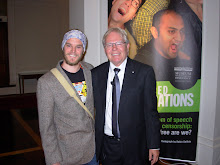Andrew Lloyd Webber's version is probably the best known version these days, but the Carl Laemmle directed film version of The Phantom of the Opera (1925) was an early classic that has stood the test of time reasonably well. It is most notable now because it features 'the man of 1000 faces' Lon Chaney in the titular role. I will soon be putting up a review of The Wolfman (1941) which stars his son Lon Chaney Jr who delivers what I think is one of the top 5-10 performances of all time in that film. The attraction of seeing his dad in this film was one of the main reasons I chose to check it out.
The story concerns the Phantom who lurks deep below the opera house in Paris, and Christine, the woman he has fallen for. This film has a lot of bland, flat narrative bits. Nothing is really happening, the direction is uninspiring and the acting outside of Chaney (who is excellent) is serviceable but nothing to write home at. Running 93 minutes, the film feels far too long. A prevalence of shadows, black cats and spiderwebs mean it opens quite atmospherically but this for some reason is lost quite early on in and is not regained. But interspersed throughout this flatness are some absolutely stunning moments. The Phantom causing a massive chandelier to fall to the ground during a performance causing widespread panic, the first time we see his masked face, and the film's surprising shift into Technicolour where the Phantom appears at a masquerade ball as death dressed in stark red. Without a doubt though the film's high point is the stunning first unmasking of the Phantom. After warning his muse Christine never to remove his mask, she cannot control her curiosity. She pulls off his mask, with Chaney sitting front on to the camera as the Phantom's hideous facial features are revealed for the first time. The shock on his face is mirrored by the audiences. The makeup (apparently done by Chaney himself) still looks spectacular even by today's standards.
In fact a lot of the design elements of this film are top-notch, helping to compensate for the narrative shortcomings. The costumes are opulent and excellent. The Phantom's aforementioned facial appearance is incredible, as are the two masks he wears throughout the film. When dressed as red death in the ballroom sequence the skull mask he wears is chilling. Likewise the mask he wears for a lot of the film is creepy even today, much more so than the style popularised by Lloyd Webber's Phantom. Stark white, almost skinlike, with it just hanging off the bottom of his face. Don't know if it was because I watched this alone after midnight the other night, but I was well and truly creeped out by it. The main opera house set is also incredible. It is massive and ornate, the scale of set is something that you would not really expect from a mid 1920s film and having it bustling with extras adds to a wonderful sense of Parisian excess. The sewer-like underground lair of the Phantom is also monumentally constructed, including vast water sources which need to be crossed in a boat.
This film is worth a watch, just to see such an early rendering of this story. And the high points are really really high. But the flatness of much of the storyline mean it is not the wholly enchanting experience it threatened to be. Check it our here, and let me know if you agree:
Verdict: Stubby of Reschs
Progress: 16/1001
Subscribe to:
Post Comments (Atom)

No comments:
Post a Comment